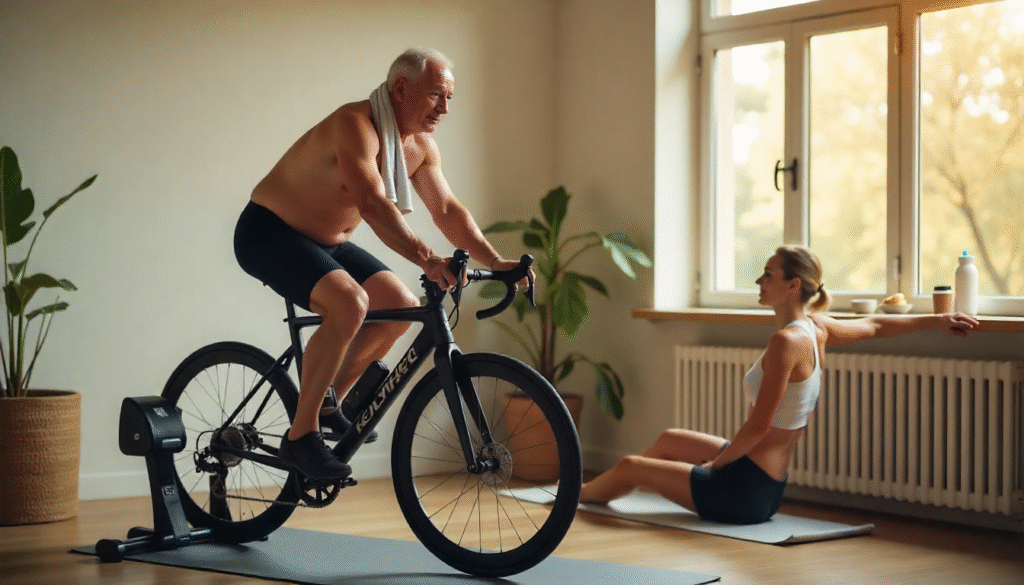The Best Fluffy Pancakes recipe you will fall in love with. Full of tips and tricks to help you make the best pancakes.
Indoor Cycling Injury Prevention for Seniors
Think you're too old for indoor cycling? Think again. This guide shares injury-prevention tips, smart training tactics, and recovery strategies that help older riders train effectively without setbacks. Perfect for cyclists over 50 who want to ride strong and stay safe.

Margaret clipped into her bike for the first time in months, her 58-year-old knees reminding her they weren’t quite what they used to be. The indoor cycling studio buzzed with energy from riders half her age, and doubt crept in – was she too old for this? Would her joints handle the intensity? The instructor’s encouraging smile helped, but the fear of injury loomed large. Sound familiar? If you’re over 50 and passionate about indoor cycling, you’ve probably wrestled with similar concerns. Your body whispers warnings that younger riders never hear: creaky joints, slower recovery times, and that nagging worry about pushing too hard. But here’s the truth – age doesn’t disqualify you from crushing those climbs and intervals. It just means you need to train smarter, not harder.
Indoor cycling after 50 isn’t about slowing down; it’s about optimizing your approach for a body that’s earned its wisdom through decades of life. This guide addresses the unique challenges older cyclists face, from joint preservation to recovery strategies that actually work. We’ll explore age-specific modifications, injury prevention techniques, and how to build lasting fitness without compromising your body’s long-term health. Whether you’re a seasoned rider adapting to changing needs or someone discovering indoor cycling later in life, you’ll find practical strategies to pedal confidently into your golden years.
Perfect Bike Fit: Your Foundation for Safe Indoor Cycling
Getting older doesn’t mean accepting discomfort as part of your indoor cycling routine – it means getting smarter about your setup. Your joints are less forgiving of poor positioning than they used to be.
• Saddle Height Magic: Ensure your knee has a slight bend at full extension – too low creates compression, too high strains hamstrings.
• Reach Reality Check: Handlebars should feel comfortable without forcing you to overstretch or scrunch up.
• Joint Protection Priority: Proper alignment prevents unnecessary stress on knees, hips, and spine.
Low-Impact Resistance: Working Smart, Not Hard
You don’t need to grind through maximum resistance to get an incredible indoor cycling workout. Your mature body responds beautifully to moderate, controlled efforts that protect your joints.
• Seated Power: Stay in the saddle for most of your ride – your knees and hips will thank you.
• Smooth Operator: Maintain that sweet spot cadence of 70-90 RPM where everything feels fluid and controlled.
• Quality Over Intensity: Focus on smooth, consistent pedal strokes rather than pushing massive watts.
Extended Warm-Up: Giving Your Body Time to Wake Up
Taking 10-15 minutes to properly warm up isn’t weakness – it’s wisdom. Your body needs more time to prepare for indoor cycling than it did in your younger years.
• Tissue Preparation: Your muscles, tendons, and ligaments need extra time to become pliable and ready for action.
• Gradual Intensity: Start with easy spinning and slowly build heat in your joints before working harder.
• Mental Check-In: Use this time to assess how your body feels today and prepare mentally.
Post-Ride Stretching: Your Secret Weapon Against Stiffness
Skipping stretches after indoor cycling means missing out on tomorrow’s mobility and comfort. Flexibility naturally declines with age, but consistent stretching slows this process dramatically.
• Hamstring Heaven: Gentle hamstring stretches prevent that “robot walk” feeling the day after intense rides.
• Hip Flexor Freedom: Counter all that hip flexion from cycling with targeted stretches.
• Lower Back Love: A few gentle stretches can prevent minor discomfort from becoming major pain.
Smart Monitoring: Understanding Your Body’s New Language
Your body over 50 speaks differently than it did in your twenties. Heart rate monitors and RPE scales become valuable translators for safe indoor cycling.
• RPE Sweet Spot: Aim for 4-6 out of 10 on most rides – challenging enough to improve, gentle enough to recover.
• Heart Rate Honesty: Use a monitor to keep intensity in check when your competitive spirit wants to overreach.
• Data-Driven Decisions: Let objective measurements guide your intensity rather than relying on how you “think” you feel.
Hydration and Electrolytes: Your Performance Partners
Dehydration hits older adults harder and faster, making proper fluid management non-negotiable for indoor cycling. Your thirst signals aren’t as reliable as they once were.
• Pre-Ride Prep: Start hydrating well before you clip in – your body needs time to process fluids.
• During-Ride Discipline: Sip consistently throughout your workout, even if you don’t feel thirsty.
• Electrolyte Intelligence: Rides over 45 minutes require more than just water – replace those minerals.
Gradual Progress: The Tortoise Always Wins
The 10% rule is your insurance policy against setbacks in indoor cycling. Your body’s adaptation mechanisms favor consistency over dramatic increases.
• Weekly Wisdom: Add no more than 10% to your ride time or intensity each week.
• Start Small: Begin with 2-3 rides per week and let your body vote on readiness for more.
• Patience Pays: Slow, steady progress beats the boom-bust cycle of overreaching and injury recovery.
Strength and Balance: Your Injury Prevention Dream Team
Adding 1-2 strength sessions weekly to complement your indoor cycling dramatically slows age-related muscle and stability decline. Think of it as insurance against falls and overuse injuries.
• Functional Strength: Focus on movements supporting cycling and daily life – squats, lunges, core work.
• Balance Training: Simple single-leg stands while brushing teeth can improve stability and prevent falls.
• Weekly Commitment: Just 1-2 sessions per week can maintain and build strength supporting cycling goals.
Rest and Recovery: Your Most Important Training Days
Rest days aren’t punishment – they’re when the magic happens. Your body needs 1-2 complete rest days weekly to repair, rebuild, and return stronger for indoor cycling.
• Recovery Reality: Your body takes longer to bounce back now, and fighting this truth leads to setbacks.
• 48-Hour Rule: If soreness persists beyond two days, reduce training volume until it resolves.
• Active Rest: Light walking or gentle stretching promotes recovery without adding training stress.
Stay Strong and Keep Pedaling: Your Age-Advantage Strategy
Indoor cycling over 50 isn’t about playing it safe — it’s about playing it smart. With the right recovery plan like in Cooling Down After a Ride and smart injury strategies from Common Indoor Cycling Injuries and How to Prevent Them, your rides can feel smoother and more empowering than ever. Keep building momentum, stay consistent, and remember: your strength isn’t behind you — it’s just shifting into a smarter gear.
Remember that proper bike fit, extended warm-ups, and post-ride stretching aren’t optional extras – they’re your foundation for consistent training. Smart monitoring through RPE and heart rate keeps you in that sweet spot where gains happen without overreaching. Gradual progression, adequate hydration, and quality rest days ensure your body adapts positively to training stress.
Most importantly, investing in proper gear and complementary strength training creates a sustainable fitness routine that supports your indoor cycling goals for years to come. Your mature body has earned the right to train intelligently, and these strategies ensure every pedal stroke moves you toward better health, not potential injury.





